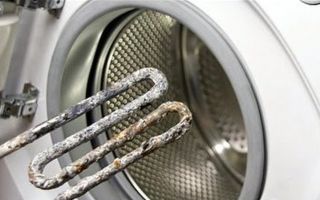Content
- 1 Can I clean my washing machine with vinegar
- 2 What vinegar is added to the washing machine
- 3 How much vinegar to add to clean the washing machine
- 4 How to clean a washing machine with vinegar and baking soda
- 5 Is there any harm from vinegar to the washing machine
- 6 Useful Tips
- 7 Conclusion
- 8 Reviews on cleaning the washing machine with vinegar and soda
Cleaning the washing machine with vinegar removes scale from the internal parts of the unit and eliminates unpleasant odors. At the same time, the procedure can be harmful, so that this does not happen, you need to know the rules of cleaning.
Can I clean my washing machine with vinegar
During operation, the washing machine interacts with a large amount of tap water. Unfortunately, the latter is not of high quality, most often the water in the pipes is hard, with a large amount of mineral impurities. Therefore, over time, scale forms on the internal parts of the machine, which impairs the operation of the unit.
Cleaning the washing machine is required not only because of the scale. After numerous washes, ordinary dirt accumulates in the device - fine threads, hair, pet hair. Powder residues can settle in the drum and tray, and mold gradually develops due to high humidity.
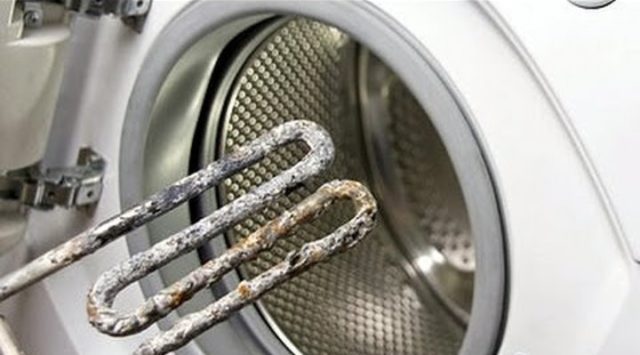
Regular cleaning of the unit helps to remove scale, fungus and bacteria. You can use regular vinegar as a cleaning agent. It has good disinfecting and dissolving properties, removes limescale deposits and eliminates unpleasant odors.
What vinegar is added to the washing machine
Universal table vinegar 9% is suitable for the care of household appliances; it can be poured undiluted into the tray. But if such a tool is not at hand, then you can clean the washing machine with 70 percent vinegar. Previously, you should simply dilute the essence with water in a ratio of 1 to 7.
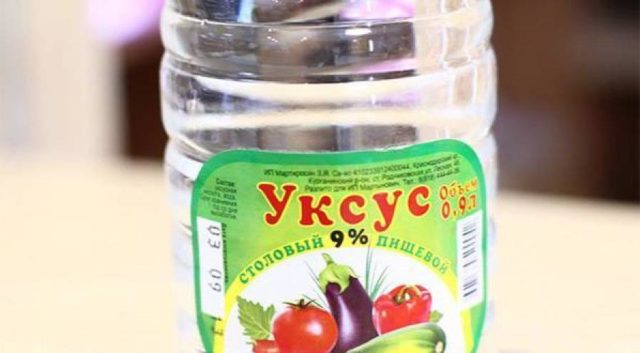
How much vinegar to add to clean the washing machine
For high-quality cleaning of household appliances, you need a little solution - about 150 ml. Usually, half a cup of 9% vinegar is poured into the powder tray.
How to clean a washing machine with vinegar and baking soda
The internal cleaning of the machine can be done in two ways. The most common one suggests using only vinegar solution to care for the unit, another option advises adding soda powder as well.
The traditional way to clean the washing machine with vinegar
To clean the washing machine with vinegar from odor and scale, you need to adhere to the following algorithm:
- The devices unload laundry from the drum and check if there are any unnoticed small things left inside.
- 150 ml of acetic acid 9% are poured into the powder compartment. If necessary, you can mix 70% vinegar essence and water in a ratio of 1 to 7, and then pour the same 150 ml of solution into the tray.
- The automatic machine door is closed and the unit is set for the longest wash cycle at a water temperature of 60 degrees and above.
- After 20-30 minutes after the start of washing, the operation of the automatic machine is stopped by pressing the pause button, and the unit is left in this state for 1.5 hours.
- During the specified period, the vinegar solution will have time to interact with all the parts of the machine and even penetrate into hard-to-reach places of the unit. When 1.5 hours have passed, the wash cycle will need to be resumed and wait until the end of the program.
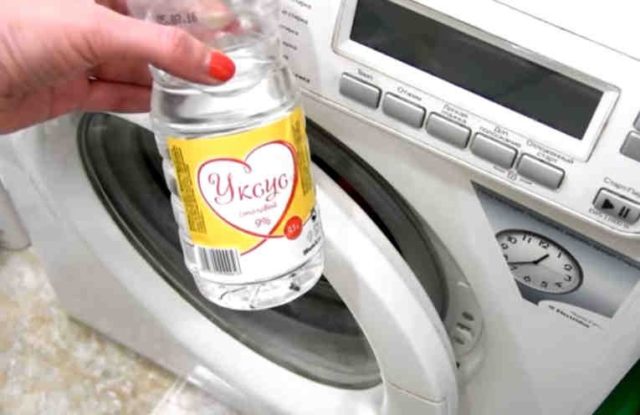
Upon completion of cleaning, you will need to unplug the washing machine, remove the drain filter located at the back of the device, and manually clean it of any remaining scale and dirt. After that, it will be necessary to dilute another 50 ml of vinegar essence in 1 liter of water, moisten a sponge in the solution and wipe the drum of the unit and the door from the inside from the inside.
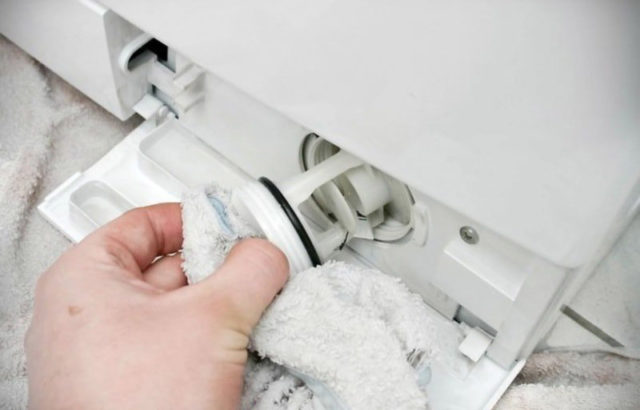
After installing the cleaned drain filter in place, the machine is turned on again and washed again. This time, no cleaning agents are added to the powder tray, and the shortest program is selected, repeated washing is needed in order to simply remove the remaining vinegar solution and scale from the unit.
Cleaning the washing machine with vinegar and soda
With a strong unpleasant odor from the unit and serious scale, you can also use baking soda. The algorithm in this case will look a little different:
- 50 g of soda powder is diluted with 50 ml of water to the state of gruel;
- the product is placed in a washing powder tray;
- 200 ml of vinegar essence 9% are poured into an empty drum of the machine;
- run the machine in the intensive wash mode at a temperature of 60 to 90 ° C for the longest cycle.
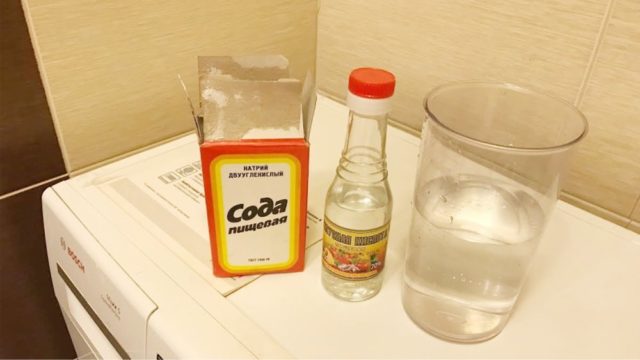
The spin must be turned off during cleaning; if there is no laundry in the drum, this mode will not be needed.
Baking soda and acetic acid will have a double effect and help to cope with even the most stubborn dirt. At the end of the wash cycle, you will need to manually clean the drain filter and wipe the drum from the inside in the same way, and then start the machine without cleaning agents in order to rinse it with water from the inside.
Is there any harm from vinegar to the washing machine
It is quite easy to descale a washing machine with vinegar. But with high efficiency and availability, the solution has some drawbacks, it can harm the machine if used incorrectly or too often:
- The strong smell of acetic acid after cleaning can remain in the machine for a long time. That is why it is important to start the unit again after cleaning is completed, this will allow the residual solution to be washed out of the internal parts. Pour in the detergent tray the strictly recommended amount of acetic acid, no more than half a glass.
- The vinegar solution is completely harmless to the metal parts of the unit. But at the same time, it can damage the silicone and rubber elements, primarily the sealing cuff. Scrubbing can make the gum stiff and easy to tear, so it should not be done too often.
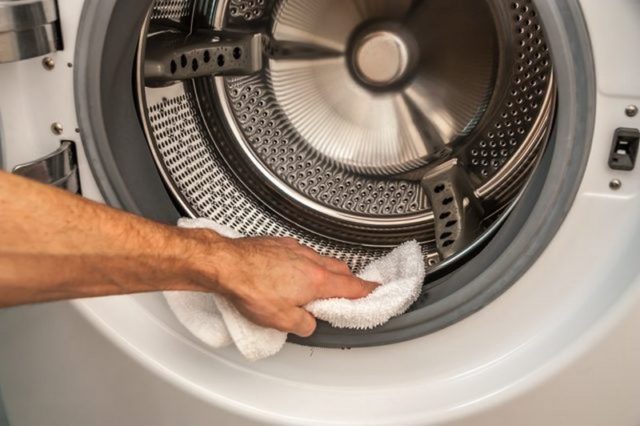
After cleaning, you need to open the drum of the unit and thoroughly rinse the seal with a clean, damp sponge to remove the remaining vinegar solution. Leave the drum and tray open for a few hours or even a couple of days to help ventilate the device.
Useful Tips
If you follow a few simple guidelines when using an automatic washing machine, then you will rarely need to clean the unit:
- The main cause of washing machine breakdowns is hard tap water with a high content of impurities. To protect the inside of the machine from scale, it is recommended to install water filters. If this is not possible, it is worth using a water softener such as Kalgon.
- In addition to chemicals, ordinary household products help soften water. When washing, baking soda can be added to the detergent tray from time to time, it has a positive effect on the composition of the water and makes it less hard.
- In addition to scale, the automatic typewriter is damaged by fine dirt that accumulates over time on the internal elements of the unit. Before washing, it is recommended to thoroughly check the pockets of your clothes, and to shake and brush the clothes to remove fine threads, hair, wool and dust particles.
- The most vulnerable parts of the washing machine are the seal and the drain filter. It is recommended to do a small cleaning of these elements every 2 months. The cuff on the hatch of the machine can be regularly wiped with soapy water, the filter must be unscrewed and cleaned manually from accumulated debris.
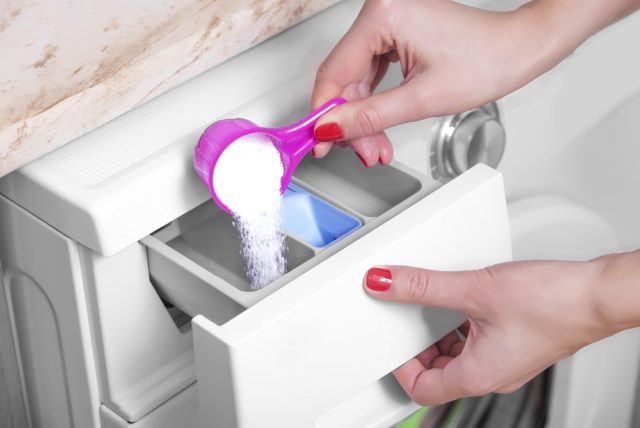
Conclusion
Cleaning the washing machine with vinegar gives a good effect, but requires strict adherence to all the rules. Table acetic acid or concentrated essence, especially when combined with baking soda, can help fight scale. The main thing is not to harm the rubber cuff during the procedure.
Reviews on cleaning the washing machine with vinegar and soda

